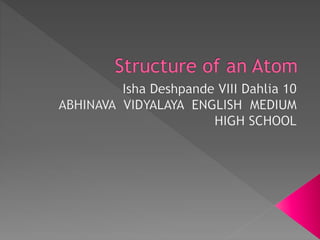
Isha deshpande 8 dahlia AVEMHS
- 2. An Atom is the smallest particle of any substance . Atoms so small in size that they can be only seen with the help of microscope . The size of a atom is measured in picometers . The name atom comes from a Greek word which means indivisible which cannot be divided further or which cannot be cut further . An atom consists of protons , electrons , neutrons .
- 3. A figure of atom which shows electrons , protons and neutrons
- 4. Electrons are negatively charged particles present in an atom . Electrons are extremely small compared to all the other parts of the atom . The mass of an electron is almost 1000 times smaller than a proton . Between 1838 and 1851 British philosopher found out that the atom is surrounded by some particles which have a electric charge After some more years it was found out as a electron .
- 5. We can only see the electrons through such microscopes
- 6. Protons and neutrons are in the center of the atom which together form the nucleus of the atom . The protons have positive charge on the other hand neutrons have no charge . The protons and neutrons together form a nucleon . The electrons revolve around the nucleons (protons and neutrons) in particular orbits .
- 7. In 1800s John Dalton performed some experiments as a result he found out the existence of atom . In 1897 J.J Thompson discovered electrons and these electrons are present in the atom . His model was like a watermelon the red part inside is like the neutrons and the black seeds are like the electrons inside it .
- 8. John Dalton was a english chemist , physicist , meteorologist . Main points of Daltons theory :- 1. Elements are made of very small particles called atom . 2. Atoms can’t be subdivided , destroyed , created . 3. In chemical reactions atoms are combined , separated , rearranged
- 9. Sir Joseph john Thompson was born on 18 December 1856 . He was an english physicist . In 1906 he was awarded the Noble Prize in physics for the discovery of electron . He was also awarded various medals and prizes like Adams prize , Royal prize , Hughes medal , Franklin medal ect.
- 11. Each part of atom is labeled +,- signs . These signs refer to the charge of particles . The protons always have positive charge and the electrons have a negative charge . If the charge is neutral the number of protons and electrons are equal . The neutrons have 0 charge that is they are neutral . The neutral charge is also known as 0 .
- 13. The atomic mass is the weight of a atomic particle . The protons and the neutrons are responsible for almost all the weight of an atom . In chemistry and physics the atomic number of chemical element is the number of protons found in the nucleus of atom . It is represented by Z . The symbol Z comes from the german word ‘Atomazal’ means atom
- 14. Rutherford had conducted experiments in which he shot relatively large, charged particles (alpha particles) at a thin gold foil. From these results, Rutherford concluded that each atom was mostly empty space, but also contained a dense region central mass, which his alpha particles could not pass through. He also concluded that this central mass must have a positive charge, to deflect the positively charged alpha particles. Rutherford and Bohr pictured the arrangement of the atom's parts to look like our solar system.
- 17. An atom is the smallest unit of matter that defines the chemical elements. Every solid, liquid, gas, and plasma is made up of neutral or ionized atoms. Every atom is composed of a nucleus made of one or more protons and usually an equal or similar number of neutrons (except hydrogen which has no neutrons . Protons and neutrons together are called nucleons. The nucleus is surrounded by one or more electrons. Over 99.94% of the atom's mass is in the nucleus.
- 18. Isotopes of carbon are 12c and 14c
- 19. An isotope is a form of chemical who’s atomic nucleus contains specific number of neutrons in additions to the number of protons that define the element . The isotope of an element is defined by the nucleon number, which is the sum of the number of protons and the number of neutrons in the atomic nucleus. For example, 16 O represents oxygen- 16, which has 8 protons and 8 neutrons, while 12 C represents carbon-12, with 6 protons and 6 neutrons .